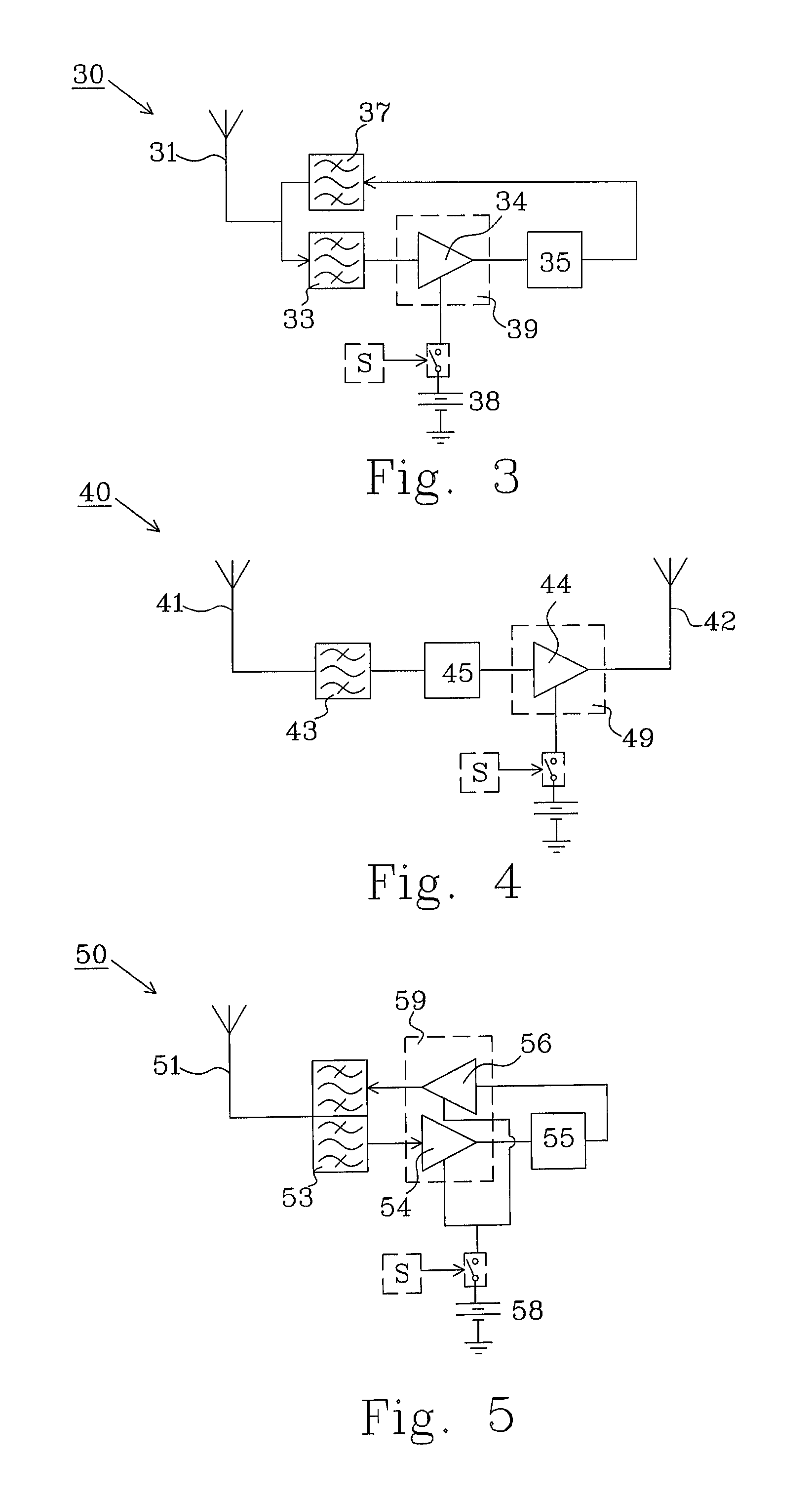Sensor-Activated Transponder
a transponder and sensor technology, applied in the field of transponders, can solve the problems of rescue personnel having to avoid detection of reflected signals, limited range of passive transponders, and lost skiers during off-piste, and achieve the effect of improving directional properties and long detection rang
- Summary
- Abstract
- Description
- Claims
- Application Information
AI Technical Summary
Benefits of technology
Problems solved by technology
Method used
Image
Examples
first embodiment
[0032]FIG. 2 shows a transponder 20 comprising an antenna structure with first antenna 21 configured to receive an incoming signal with RF power of a first frequency f1, and a second antenna 22 configured to retransmit the incoming signal as an output signal with RF power of a second, preferably harmonic, frequency. A first frequency filter 23 is connected to the first antenna 21 and is tuned to the first frequency in order to avoid, i.e. prevent or at least reduce the influence of, incoming signals with RF power of frequencies other than the first frequency from being amplified in a first amplifier circuit 24. The amplified incoming signal is thereafter fed to a frequency converter 25 that frequency converts the incoming signal into the output signal, preferably by frequency multiplication of the incoming signal with RF power of the first frequency f1 to obtain an output signal with RF power of a harmonic frequency.
[0033]The output signal is thereafter amplified in a second amplify...
second embodiment
[0034]FIG. 3 shows a transponder 30 comprising an antenna structure with a single antenna 31, which is configured to receive incoming signals having a first frequency f1 and to transmit signals having a second, preferably harmonic, frequency f2. A first frequency filter 33 is connected to the single antenna 31 and is tuned to the first frequency in order to avoid, i.e. prevent or at least reduce the influence of, incoming signals with RF power of frequencies other than the first frequency from being amplified in an amplifier circuit 34. The amplified incoming signal is thereafter fed to a frequency converter 35 that frequency converts the incoming signal into the output signal, preferably by frequency multiplication of the incoming signal with RF power of the first frequency f1 to obtain an output signal with RF power of a harmonic frequency.
[0035]The output signal is, in this embodiment, thereafter filtered in a second frequency filter 37 which is connected to the single antenna 31...
third embodiment
[0036]FIG. 4 shows a transponder 40 comprising an antenna structure with a first antenna 41 configured to receive an incoming signal with RF power of a first frequency f1, and a second antenna 42 configured to transmit an output signal with RF power of a second, preferably harmonic, frequency. A first frequency filter 43 is connected to the first antenna 41 and is tuned to the first frequency in order to avoid, i.e. prevent or at least reduce the influence of, incoming signals with RF power of frequencies other than the first frequency from being frequency converted and thereafter amplified in an amplifier circuit 44. The filtered incoming signal is fed to a frequency converter 45 that frequency converts the incoming signal into the output signal before being fed to the amplifier circuit 44. The frequency conversion is preferably performed by frequency multiplication of the incoming signal with RF power of the first frequency f1 to obtain an output signal with RF power of a harmonic...
PUM
 Login to View More
Login to View More Abstract
Description
Claims
Application Information
 Login to View More
Login to View More - R&D
- Intellectual Property
- Life Sciences
- Materials
- Tech Scout
- Unparalleled Data Quality
- Higher Quality Content
- 60% Fewer Hallucinations
Browse by: Latest US Patents, China's latest patents, Technical Efficacy Thesaurus, Application Domain, Technology Topic, Popular Technical Reports.
© 2025 PatSnap. All rights reserved.Legal|Privacy policy|Modern Slavery Act Transparency Statement|Sitemap|About US| Contact US: help@patsnap.com



